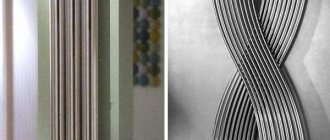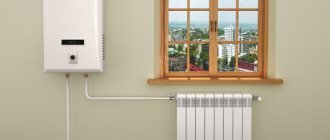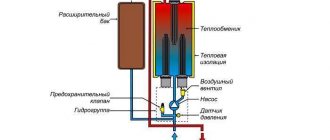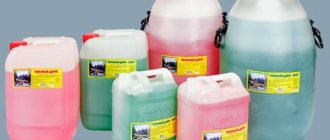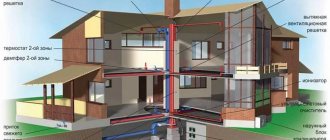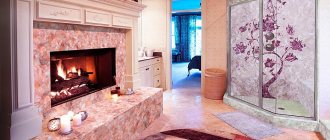Only at first glance it seems that it is enough to install a boiler, lay pipes, connect radiators to them, and the heating system will be ready. In fact, the above is mandatory, but not a complete list of everything that is necessary. The heating equipment that is required to heat a private home will form a fairly impressive list, and the use of each element from such a list is conditioned by ensuring normal conditions for the operation of the entire system.
Alternative heat sources
Today, a great variety of different types of appliances are used, thanks to which economical heating of a private, country or country house is achieved.
- solar panels;
- heat pumps;
- geothermal heat sources.
The sun will always be eternal, and, most importantly, an absolutely free source of energy. Its use for heating homes has been used since ancient times. Modern solar panels effectively heat rooms and save money spent on heating homes.
Solar panels are increasingly found in private homes.
Heat pumps are becoming increasingly popular; their use helps heat rooms in all weather conditions. Geothermal heat sources are also widely used in some regions rich in this type of thermal energy.
It is worth noting that the use of such heat sources is becoming more and more economically feasible compared to traditional equipment running on gas or solid fuel.
It should be noted that such modern units are quite expensive, their purchase and installation will cost a little more, but this price of an alternative source of thermal energy will be recouped within several years.
Summary
There are various economical heating systems aimed at maintaining the required temperature without compromising the level of comfort of a country house.
It has been proven that the installation of additional equipment or energy-saving devices significantly simplifies and automates the processes of maintaining and regulating comfortable temperature conditions. The use of such devices and units is not only convenient, but also profitable.
Main types of fuel
Modern heating systems for private households today use a variety of types of heat carriers and fuels.
| Fuel | Heat of combustion kW/kcal | |
| Electric Energy | 1 | 864 |
| Natural gas | 9,3 | 8000 |
| Liquefied gas | 12,2 | 10500 |
| Coal | 12,5 | 10800 |
| Charcoal | 7,8 | 6700 |
| Wood pellets | 4,9 | 4200 |
| Wood (firewood) | 2,2 | 1940 |
The most expensive types of fuel are considered to be diesel fuel, fuel oil and liquefied gas, as well as electricity used by boilers, convectors, heaters and radiators. A less expensive option is to use solid fuel. The most practical is the use of natural gas
Latest heating systems
An example of a fairly affordable and at the same time effective system, suitable for both a country house and an apartment, is an electric heated floor. By incurring relatively small expenses for the installation of such heating, you can provide your home with heat and not buy any boilers. There is only one drawback - the cost of electricity. But considering that modern underfloor heating is quite economical, and if you have a multi-tariff meter, this option may be acceptable.
In southern regions with high solar activity, another modern heating system performs well. These are water-based solar collectors installed on the roof of buildings or other open areas. In them, with minimal losses, water is heated directly from the sun, after which it is supplied to the house. One problem is that collectors are absolutely useless at night, as well as in the northern regions.
Various solar systems that take heat from the ground, water and air and transfer it to a private home are installations that implement the most modern heating technologies. Consuming only 3-5 kW of electricity, these units are capable of “pumping” 5-10 times more heat from outside, hence the name – heat pumps. Then, using this thermal energy, you can heat the coolant or air, at your discretion.
Filtration
Home equipment - heating and water supply, plumbing fixtures and household appliances - requires at least coarse water filtration. The presence of sand in it leads, at best, to a decrease in service life, and at worst, to instantaneous failure of the equipment. A typical example of the second scenario is ceramic cartridges and faucets: an attempt to block a ceramic valve jammed by a grain of sand leads to its destruction.
In addition: SanPiN 2.1.4.1074-01 contains a number of requirements for the composition and quality of water supplied for drinking needs. Taking these requirements into account, water from an autonomous source almost always requires fine filtration.
Coarse filters
The vast majority of filters for coarse water purification are a set of stainless mesh and a small sump for retained debris. Debris is removed after opening the filter housing or through the drain valve.
Mechanical filter with drainage
Functions: protection of plumbing, pumps, water meters, etc. from mechanical damage from sand.
Installation: into a water pipe break in front of equipment in need of protection; at the water supply inlet. In houses with centralized water supply, mechanical filters are placed in front of the water meter.
Fine filters
Types: osmotic (with a membrane permeable to molecules of a certain size); carbon (with adsorbing cartridges filled with activated carbon).
Fine filter with osmotic membrane and carbon cartridges
Functions: obtaining drinking quality water.
Note: according to SP 30.13330.2012, water that has not undergone fine purification can be supplied to urinals and flush tanks.
Installation: in front of plumbing fixtures from which drinking water is drawn. Osmotic filters are additionally connected by a drainage outlet to the sewer system, into which water contaminated with impurities that has not passed the osmotic membrane is discharged.
Geothermal installation
Its operating principle is similar to the hydrothermal option. The difference is that the heat of the earth is used, not water.
Equipment Features
Laying the outer contour can be done both vertically and horizontally. The vertical arrangement is due to a number of difficulties during the installation process. For pipes it is necessary to drill wells to great depths. But there are two negative aspects associated with horizontal laying:
- a large area of private land is required to accommodate the circuit;
- it is impossible to plant plants because the collector will cool their roots.
In both cases, heat is taken directly from the soil near a private building. The geothermal pump responsible for pumping the coolant is located in the house itself. The shaft with the heat exchanger should be located in close proximity to the building.
Advantages of using earth's heat
This system has the following advantages:
- The thermal energy of the earth is an inexhaustible source of energy;
- autonomous operation of the system;
- absolute fire safety, no risk of fire;
- minimal energy consumption;
- there is no need for fuel delivery and storage;
- long service life.
The high cost of the object is the main disadvantage. A geothermal installation for the same square footage as in the previous case will increase to 600 thousand rubles.
Advantages and disadvantages of water supply options
Central water supply
Advantages:
- Purified water complies with SanPiN
- Quality control
- No pump required
Flaws:
- High price
- Possible low pressure
Artesian well
Advantages:
- Low cost of water lifting
- Adjustable pressure
- No chemical contamination, no disinfection required
Flaws:
- Filtering required
- May require removal of metal salts
- Construction costs
Surface well, well
Advantages:
- Costs are lower than for an artesian well
- Adjustable pressure
Flaws:
- Filtering required
- Cleaning required
- Primary water is contaminated
- Possible presence of harmful chemicals
- Disinfection may be required
Surface reservoir (river, lake, pond), rainwater
Advantages:
Minimal costs if a body of water is nearby
Flaws:
- Water, highly polluted, with the presence of chemicals used in agriculture
- Use without filtration, purification and disinfection is hazardous to health.
- High costs for water treatment
The comparison shows in what order preference should be given to water supply options.
Solar panels
Using solar energy for heating is the most inexpensive and accessible way. The main task is to convert sunlight into heat with minimal losses.
System design
The main element of such a system is the solar collector. This is a device consisting of tubes that lead to a coolant reservoir. There are vacuum, air and flat collectors. In addition to them, the composition includes the following units:
- heat exchanger;
- storage tank;
- pipeline;
- front camera.
A storage tank is a container with heated coolant. From the top of the container, liquid is supplied to the heating devices. After passing through the entire heating circuit, the cooled coolant again enters the tank.
The anterior chamber serves to prevent air retention in the heating pipeline. It is a tank that is located at the highest point of the system. Collectors must be installed at an angle of 35–40°. This slope will ensure maximum efficiency. To minimize heat losses, all pipelines leading from the collector to the heat exchanger must be insulated.
Advantages and disadvantages
It is worth noting the main advantages of a solar battery:
- high efficiency;
- long service life - more than 25 years;
- ease of maintenance;
- independence from low air temperatures.
But it is still better to use batteries as an additional source of heat for private homes. In winter, the sun's energy will not be enough to accumulate the required amount of heat. During periods of increased cloudiness, your home may also remain cold. New technologies make it possible to combine several types of heating into one complex, and solar panels can be combined with a geothermal installation or infrared radiation.
Disadvantages also include very high prices for solar collectors and equipment. To heat a 100 m² house, installing solar panels will cost approximately 900,000 rubles.
Modern heating boilers
Boiler equipment is still in demand, but traditional heating units have been replaced by new devices that meet all quality criteria and have very decent technical characteristics.
Condensing boiler
The operation of a new type of heat generator is based on the formation of carbon dioxide and water during the combustion of fuel, releasing a large amount of energy. The design of such a boiler includes a combustion chamber with a burner, a fuel supply system and a fan for forcing air, as well as an after-cooling chamber and a reservoir in which condensate is collected.
The efficiency indicators of a gas condensing boiler reach 97% (for traditional ones a maximum of 93%), which significantly exceeds similar data for equipment operating using liquid and solid fuels. In this way, you can achieve not only maximum efficiency of the autonomous heating system, but also make energy consumption as economical as possible.
Many European countries are abandoning the use of traditional gas boilers and are switching to a modern new solution in heating systems - condensing boilers.
Wall-mounted gas boilers
Floor-standing versions have been used less and less lately. The installation of wall-mounted models operating on liquefied or main gas is becoming relevant. It provides not only heating of the premises, but also uninterrupted hot water supply to the house. Wall-mounted equipment has a number of advantages, including compact dimensions and a completely modern design.
From a design point of view, devices with an open and closed combustion chamber in single- and double-circuit versions differ. When choosing a model, it is advisable to focus on the power indicators of the unit, its dimensions (especially important in small rooms), as well as the presence of the necessary functionality.
In terms of efficiency, only condensing boilers can compete with wall-mounted gas boilers, but they are also quite expensive.
Electric boiler with automation
The last word in arranging a heating system for a country house is electric boilers, equipped with weather-dependent automation or an option for automatic increase/decrease of power. A whole range of additional expensive equipment provides fuel consumption control and also prevents excessive cooling or severe overheating of the air in the room.
The cost of such boilers is quite high, but the advantages of operation are quite obvious. There is no need to regularly manually change temperature settings depending on weather conditions. Well-proven models are durable and easy to maintain, have a high degree of reliability and are safe to use.
Coal-fired bunker-type boilers
If you look at new solutions in heating systems based on coal boilers, bunker solutions stand out. Bunker-type solid fuel units differ in the capacity of the built-in fuel tank and other important technical characteristics. The high demand for such models is due to an automatic screw fuel supply mechanism, forced air injection and removal of combustion products, and a self-cleaning function.
In devices of the new type, uninterrupted operation is ensured by a microprocessor controller and an electric ignition system. When fuel is supplied in portions, complete combustion occurs and a minimum amount of unburned fuel is observed with maximum thermal output. Bunker equipment is most often equipped with a retort burner or an AKM burner device.
The latest technologies and heating equipment are at your service
Scheme of a double-circuit heating system
With them, modern home heating can be arranged in such a way that you control not only the amount of heat, but also its distribution across different rooms. This became possible thanks to a system of devices operating according to a planned algorithm. Moreover, they are easy to choose for a room of any size and purpose.
Thus, one type of heating system is designed specifically for cottages or small country houses, another for multi-story buildings, and a third for large urban areas. But, since you are interested in installing heating for a country house or apartment, we took a closer look at these particular systems.
They differ in the type of coolant, operating principle and additional capabilities.
Water heating
During the operation of the water system, fuel is converted by the boiler into heat, which heats the water, and it heats the elements of the heating circuit.
You will learn about the nuances of connection and operation:
- gas, electric and solid fuel boilers
- single- and double-circuit units
- chimney and turbocharged structures
System elements
Water heating system
Hot water flows through pipes to the direct elements of the system, which heat the room. It can be:
- radiators
- warm floor
- heating coils
- boilers
- various heat exchangers
Radiators
How to choose the right radiators?
Having given off most of the heat to the radiators, the cooled water is returned to the boiler, where it is heated again. And the heating cycle repeats. You will understand how to choose the right radiators, and which ones are best to choose:
- on steel
- cast iron
- aluminum
- or bimetallic
You will learn which pipes are best to use, how to correctly calculate the required quantity, and what rules to use when choosing them.
Circulation pumps
A pump that forces water throughout the entire heating circuit.
In modern heating systems, circulation pumps are widely used, which force water throughout the heating circuit.
In the corresponding section of the site you will find information about:
- in what rare cases can you do without pumps?
- what are their advantages and design features
- how to properly flush your heating system
- what rules should be followed when servicing circulation pumps
Boilers and electric heaters
Many heating systems provide home residents with more than just heat. When it is necessary to solve the problem of hot water supply, the water is heated in special tanks - boilers. If these devices are relevant to you, you can familiarize yourself with the principles of their operation and installation. And they run on electricity - a safe, simple and convenient source of energy.
Warm floor
They provide additional comfort in your home or apartment, especially if you have small children. You will learn how to carry out calculations, correctly install such a system and take a comprehensive approach to the issues of providing heat in the house.
Air heating
Individual climate in the house
This heating system is one of the most promising ways to heat private houses and cottages. Its main advantages are simplicity and reliability.
You will get acquainted with the features of this system and learn how to choose each of its elements correctly:
- gas air heaters
- galvanized iron air ducts
- special gratings
Collector systems
Heating installation and design of collector systems can be done entirely by yourself. If you are interested, you will find information on how best to do this and why such systems are considered universal.
Everything for a private home or cottage
Which heating system to choose in a private house
If you need to install a heating system for a private home or cottage, we will advise you:
what tasks should you pay attention to first of all what issues should only be solved by specialists what and how you can do it yourself how to check the correctness of each stage of work
If you want to heat a dacha, garage, temporary shed, greenhouse or other outbuildings, you will also learn about all the nuances of choosing methods for heating them from the materials on the site.
And finally...
Heats by steam
The operating principle is similar to water heating. But instead of water, steam passes through the pipes. This type of heating was extremely popular just a few decades ago. But now they hardly use it. First of all, due to the high risk during operation. Heating devices used in this scheme become very hot. In case of accidents of steam equipment, people nearby receive severe burns.
Alternative types of heating systems
Gravity heating scheme.
Innovative methods of heating private houses are distinguished by safety during operation, efficiency, and compactness.
New heating systems for individual suburban housing allow you to change the power of heating devices in the system according to the wishes of the owner.
New heating systems use high-quality pipelines of a new generation, updates in system wiring, which improve economic performance.
Avant-garde heating systems are designed in such a way that it is possible to adjust the supply of coolant to actual weather conditions and taking into account the time of day. New heating systems provide for the installation of special regulators with a timer, which is programmed to automatically turn on/off to maintain the set temperature at night. Thermostatic valves are installed on radiators to regulate the temperature in each room of a private house.
Alternative and economical heating systems include:
- heating using solar energy;
- Heat pump;
- vacuum solar collectors;
- heating using propane-butane;
- infrared heaters;
- film radiant electric heaters - PLEN;
- heating system "Smart Home".
Normalization of pressure
Equipment for water supply and heating systems can only operate within a certain pressure range. In particular, for cold water and hot water systems, SP 30.13330.2016 sets a pressure standard of 4.5 kgf/cm2.
In some cases, the pressure at the inputs of houses with centralized water supply is higher than the standard. This is a necessary measure to compensate for uneven terrain or uneven number of floors in buildings.
In such cases, the input is equipped with pressure reducers. They come in piston and membrane types.
Piston reducer at the cold water inlet
- Functions: reducing water pressure to standard values. Many gearboxes allow manual adjustment of the output pressure in the range from 1 to 5 kgf/cm2.
- Installation: at the water supply inlet or in front of plumbing fixtures that need protection from overpressure, taking into account the direction of water flow. It is indicated, as in the case of a check valve, by an arrow on the body.
Using coal
Many private houses are located far from the gas pipe. Buying firewood in some regions is more difficult than buying coal. You can purchase equipment that runs on solid fuel. Boilers designed to burn coal have sensors to regulate the heating temperature. The use of coal will reduce the amount of harmful substances resulting from combustion.
When choosing firewood or coal, you should decide in advance where and at what prices you will purchase fuel.
Solid fuel boilers consist of a furnace, in which the coal combustion process takes place, a heat exchanger, where the coal is heated, and a grate. The heat exchanger can be made of cast iron or steel. Depending on this, you can find cast iron or steel boilers on the market. Which material is preferable? Steel boilers are slightly cheaper. Why? A cast iron boiler will last longer. As for reliability, these structures are difficult to damage.
https://youtube.com/watch?v=qjwrEuT3WZ4
The advantages of coal stoves include durability and high heat transfer. The heating system does not require electricity. It is clear that coal will have to be purchased in advance and a room for its storage will have to be provided.
conclusions
It is a well-known fact: the more efficient an innovation in a heating system is, the more expensive it is, although it requires lower operating costs. Conversely, high-tech electric heating systems that are cheap to install force us to pay subsequently for the electricity consumed. Heat pumps are so expensive that they are inaccessible to most citizens of the post-Soviet space.
The second reason why homeowners gravitate towards traditional systems is the direct dependence of modern heating equipment on the availability of electricity. For residents of remote areas, this fact plays a big role, which is why they prefer to build brick stoves and heat their houses with wood.
Operating principle of infrared heaters
When studying new technologies in heating, you can immediately pay attention to such a device as an infrared heater. This source of heat energy can be used for both local and widespread heating
This type of equipment is a device that is capable of emitting infrared waves in a certain range. Such waves easily pass through any air barrier and are capable of heating any object that is in close proximity to them.
Operating principle of an infrared heater
For home use, the best models are those that operate on a 220V network. The main component of the device that emits heat is the heating element or open coil. Light waves come from the reflector, and this allows you to heat exactly the space or object at which the device is directed.
Ceiling IR heaters are often used to increase the temperature in rooms such as a garage, utility room, small warehouse and others.
In order to heat the walls of a room, ceiling or floor, you can use infrared innovative film-type heating systems. Such systems can be easily hidden under decoration.
Ceiling infrared heater
Disadvantages and advantages of heating using IR devices
Such modern heating is considered the most suitable and profitable from the point of view of saving energy resources. The efficiency of such a heating system can rise to 95%, plus the room heats up quite quickly. This allows you to optimize all costs as efficiently as possible. One important point to remember is that such modern heating systems for private houses must be additionally equipped with automatic regulators operating on the basis of thermostats.
The infrared heating device is completely safe for both humans and the environment. It does not release toxins or other harmful substances.
Its main disadvantage is considered to be its rather high cost. If you need to install a heating system for the entire building, you will need to spend a lot of money. Of course, these new technologies for heating a private home will fully pay for themselves over time, but not everyone will agree to wait such a long period of time.
Heating boilers
Among the new products in this category that have appeared on the construction market, the following samples can be noted:
induction type boilers operating from the electrical network. These structures are a pipe consisting of a dielectric with a metal core placed inside. They got their name due to the presence of an induction coil wound on top of the pipe. It is this part of the boiler that is the source of energy currents. As a result, the device heats up and transfers thermal energy to the coolant, which, as a rule, is ordinary water. Among the advantages of this model is high productivity, despite its very small size.
In addition, the design of the induction boiler does not have components prone to wear, which is also important; boiler, called an electrode boiler. Its shape is also extremely convenient due to its small size
Heating of the coolant is achieved by placing two electrodes inside it, as a result of which the water, which is an electrolyte, is heated. The peculiarity of this boiler model is that it is completely safe for operation, since if even a minimal leak occurs, the mechanism will immediately stop working due to the principle of its design. However, due to the fact that the functioning of such a boiler directly depends on electricity, its operation can hardly be called economical, since electricity costs will be very significant, despite the assurances of many sellers of this equipment; boilers called condensing boilers. These mechanisms are heating elements that run on gas, or more precisely, on the energy obtained from its combustion. This means that all combustion products condense on a specially designated heat exchange element, due to which it is heated. What makes such boilers notable is that their performance is very high (the efficiency can reach 100% or even more, provided that the total volume of thermal energy released is taken as 100%). The operating principle of such a boiler is based on a process called pyrolysis. Firewood, which serves as the main fuel, burns in two stages. Initially, combustion takes place in conditions of a small amount of oxygen, resulting in the appearance of ash and gas, which subsequently burns in a separate chamber. Thanks to this operating principle, it becomes possible to control the operation of the boiler and distribute heating throughout the entire home as conveniently as possible.
Heating buildings with a heat pump
A heat pump is a device that uses thermal energy obtained from the environment to heat a home. The principle of operation of this installation is that, using an external circuit, several degrees of heat are taken from a heat source in the environment and, under the pressure created by the pump system, it is converted into energy, with the help of which the coolant is heated to 70 ° C.
This type of room heating technology uses the following heat sources:
- air;
- solar radiation;
- water from natural sources;
- groundwater;
- the soil;
- sewage water and waste.
The advantages of this heating method include: compact installation, safe operation, no need for a ventilation system, and environmental friendliness.
Shut-off valves
Shut-off valves include taps, filters, gate valves, pressure gauges, control valves, thermostatic devices, pressure reducers and much more. Shut-off valves are an important and integral part of the entire complex system. This is an element that regulates temperature by controlling the flow of gas and liquid.
There are 4 types of shut-off valves:
- Safety.
- Reverse.
- Regulatory.
- Distribution and mixing.
Thanks to shut-off valves, you can be sure of the safe and productive operation of the entire pipeline system.
Video about alternative heating sources
Video about making a wind generator with your own hands:
Video about combining alternative sources to generate electricity in a small country house:
A short video about using a heat pump:
It is quite possible to abandon traditional heating sources. To do this, you need to carefully select an alternative or combine several, based on the characteristics of the area, the area of your country house and the local area. The energy of the sun, earth, wind power, and the disposal of household waste of plant and animal origin are quite capable of becoming a worthy replacement for gas, coal, firewood and paid electricity. published econet.ru
Selection of building heating systems
Technological progress leads to the fact that new technologies are constantly emerging in the field of heating individual housing. And since harsh winter weather forces Russians to spend large sums of money, the emergence of innovations in the heating sector provides an opportunity to reduce these costs.
Diagram of the operating principle of geothermal heating.
To correctly select a heating system for individual housing, it is necessary to highlight important points:
- availability of fuel type;
- area of the heated room;
- estimated financial costs for operating this heating method;
- efficiency of the heating system in comparison with other heating methods;
- factors affecting the durability of heating equipment and its environmental friendliness.
The latest technologies in heating are developed using available types of fuel and allow you to freely use heating equipment and devices, leave them in automatic mode, easily adjust the temperature regime, and different operating parameters of the systems. The efficient operation of equipment using new technologies makes it possible to maintain a comfortable temperature, choose efficient heating of houses and at the same time save money.
Pipes: what they are, how to choose
For the autonomous system to work properly, the pipes must withstand pressure of up to 2 atmospheres and liquid temperature of up to 95 degrees. They should last for decades and ensure tightness. For external pipes it is also good to have a decent appearance.
You can increase the thermal energy in a pipe by using pipes with a larger diameter, or by speeding up the movement of fluid. It must be remembered that excessively fast fluid movement creates hydraulic noise. This is extremely uncomfortable for life. Therefore, you cannot accelerate the movement more than 1.5 m/s. And knowledgeable plumbers do not recommend exceeding the 1 m/s mark. Making it below 0.25 m/s is also not advisable - there won’t be enough power to push through the air pockets.
In older houses, a system of steel pipes in combination with cast iron radiators was often used. This technology is outdated. New materials guarantee new characteristics. Which pipe materials are better?
- Metal-plastic – base made of aluminum composition, shell made of polyethylene. They are used in hot and cold water supply. Pros: tightness, good throughput, resistance to tearing.
Metal-plastic pipes
- Copper pipes have been used for 3 centuries and this material has proven itself well. Copper pipes are strong and durable and do not collapse for decades. For the shell, a layer of polyethylene or polyvinyl chloride is sometimes made on the outside.
Copper pipes
- Steel pipes are the most popular in the absence of alternatives. They are durable, have a low expansion coefficient, and are indispensable in heat supply and steam heating. Cons: the material is susceptible to corrosion.
Steel pipes
- Stainless steel pipes are made from alloy steel. Due to their durability and resistance to corrosion, they pay for themselves in several years, although they are not cheap. There is no need to frequently repair the pipeline or change its individual parts.
Stainless steel pipes
- Polypropylene pipes (PP or PPR) have moved from water supply to heat supply. PP pipes will last from 30 to 50 years. There is no corrosion on them. They are not afraid of aggressive components in the coolant composition.
Polypropylene pipes
The pipeline operates without failures if:
- Consider the heating system diagram before purchasing pipes;
- Calculate 4 parameters: required pipe diameter, heating system power, coolant speed, hydraulic calculation;
- Buy only from trusted manufacturers.
A short summary
Alternative heating options will help every owner of a modern country property (be it a cottage or a small dacha) to ensure efficient heating of their home and create the most optimal living conditions.
At the same time, despite the rather significant cost of the initial installation of some types of heating systems (for example, heat pumps), the alternative to gas will still be cheaper than the traditional method of heating rooms
And the level of safety of heating systems will be significantly increased by eliminating mains or liquefied gas, which is important, given the number of accidents involving gas systems
Electric heating
Electrical space heating refers rather to traditional heating methods that have been modernized in recent decades. Electrical appliances are easy to use, convenient and reliable. They have long been used for local heating.
To evenly heat the entire area of a room using electricity, heated floors are used. This system is convenient for use in a country private house.
